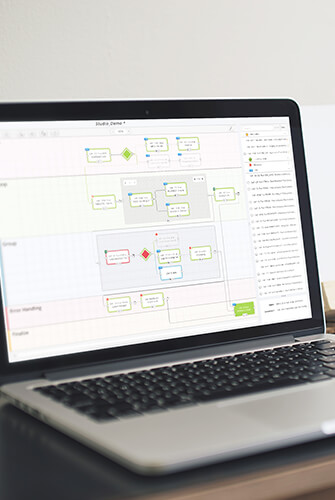Automating Compliance for IFRS 15, 16, and 17

1. New and evolving standards
New and evolving standards are a consistent and challenging reality for enterprise finance teams. These updates add to the overall burden of activities such as timely completion of the period-end close.
We’ve written about how automation can improve the elements of the financial close – but how can a strategic approach to automation help your teams adapt to revised regulations? With a number of new and updated/replaced IFRS standards in recent years, understanding how finance process automation can improve your teams’ ability to stay in compliance is a key advantage.
This guide covers what finance leaders need to understand about each of these updates, and how automation can help you stay agile and responsive. Expand the below sections for specialized information and insights on how finance automation can be leveraged to stay compliant with IFRS 15, 16, and 17.

2. IFRS 15 revenue recognition compliance and finance automation
WHAT IS IFRS 15?
The introduction of International Financial Reporting Standard (IFRS) 15 was led by the International Accounting Standards Board (IASB) and came into force in January 2018. It was introduced to standardize guidance internationally on accounting for revenue from contracts with customers. This is to ensure organizations recognize and report revenue from contracts at the right time, when the services or products sold have been fulfilled.
According to the IFRS Foundation guidance, IFRS 15 establishes the principles that organizations apply when recognizing the type, amount and timing of revenue from the sale of goods or services to a customer. This guidance includes five steps organizations must now apply to correctly recognize revenue under IFRS 15. These are:
- Identify the contract with a customer.
- Identify the performance obligations in the contract.
- Determine the transaction price.
- Allocate the transaction price to each performance obligation
- Recognize revenue when a performance obligation is satisfied by transferring a promised good or service to a customer.

WHAT IS THE CHALLENGE FOR FINANCE AND ACCOUNTING?
One of the main challenges for finance is correctly accounting for the revenue from contracts that contain a bundled mix of physical goods and services, such as an IT project that includes computer hardware, software licenses and consultancy services. Whereas previously this might have been accounted for as a single transaction, each element of the bundle has to be accounted for and recognized separately. And, under IFRS 15, different types of revenue have different rules about the timing of when they can be recognized and reported.
This means finance teams must better understand the contracts the organization has with its customers and then align the costs with the revenues from those contracts using the principles defined by IFRS 15.
In a bundled contract scenario, finance teams must essentially unbundle the different elements and, using the five-step IFRS 15 framework, calculate how much revenue is assigned to each part of the contract and when they can recognize and account for each of those elements in compliance with reporting guidance.
To achieve this, finance needs more granularity in the contract data it uses for accounting than in the past so it can correctly calculate the portion for physical goods, person hours and any other elements of the contract. It requires more detailed data and more manipulation of that data to ensure compliance with IFRS 15.
For many organizations, their ERP systems will contain a lot of this data and have the functionality to do things such as earned value analysis. However, this still requires a lot of manual effort to upload the data and run reports in the ERP system.
HOW CAN REDWOOD FINANCE AUTOMATION SUPPORT IFRS 15 COMPLIANCE?
To apply finance automation effectively to help with IFRS 15 compliance, there are three key elements organizations need to have. These are: a repeatable contract bundle; contract data that is digitalized and detailed; and a defined methodology and process according to IFRS 15 rules.
The sweet spot where finance automation can really help with revenue recognition under IFRS 15 is when an organization has a repeatable product/service bundle that it sells to customers.
Take the example of a technology supplier that implements SAP for customers. A multi-year contract bundle like this might include supplying the physical computing infrastructure, the SAP software, as well as the consultancy service to configure the software, implement it, run it, and support and maintain it for the customer.
In that scenario, finance must identify clearly and analyze at a very granular level—usually from data in its ERP system—what types of goods or services are being sold as part of that bundle, what costs have been incurred, and what the correct revenue recognition period is for each of those goods and services.
Under IFRS 15 there are different recognition and accounting rules that apply for different types of revenue and according to when a performance obligation is fulfilled. For an IT project like the above example, some revenue might not be recognizable until the customer is live and running on the new software, whereas other types of revenue, such as supplying physical computer hardware can be recognized straight away, typically on acceptance by the customer.
With a repeatable goods/services bundle where the components are the same from contract to contract, even if the exact specification and volume varies, Redwood can automate the data retrieval process, perform automated splits and calculations and propose the required postings. By doing this, finance automation eliminates manual effort, creates a structured, compliant and auditable process and ensures fast processing.
3. IFRS 16 lease accounting compliance and finance automation
WHAT IS IFRS 16?
International Financial Reporting Standard (IFRS) 16 replaces International Accounting Standard (IAS) 17 and has been effective from 1 January 2019.
IFRS 16 affects most companies that lease or rent assets such as equipment, machinery, vehicles and property. The major change that IFRS 16 has brought in is to bring accounting for most leases onto the company balance sheet to improve transparency of reporting. That includes operating leases, which previously would have remained off the balance sheet as an in-year expense.
The IFRS Foundation guidance for IFRS 16 states:
“The objective of IFRS 16 is to report information that (a) faithfully represents lease transactions and (b) provides a basis for users of financial statements to assess the amount, timing and uncertainty of cash flows arising from leases. To meet that objective, a lessee should recognize assets and liabilities arising from a lease.”

WHAT IS THE CHALLENGE FOR FINANCE AND ACCOUNTING?
Under IFRS 16, finance teams and accountants have to create an asset and capital value on the balance sheet for the leased item they have right-of-use for, recognize the depreciation of that asset’s capital value over the duration of their right-of-use, and separate out the interest and liability of the financing.
Finance teams must first identify if IFRS 16 applies to a lease and if it does, they must calculate and split the lease payment between the capital value and the interest or finance paid on it. Using the example of a leased car, if the company has exclusive rights to use that car for the duration of the lease agreement then IFRS 16 will apply. If the monthly lease payment is £1,000, the lessee must calculate the amount that is recorded within the interest account versus the amount that is for the use of the car itself.
Applying IFRS 16 guidelines means that finance must calculate the asset value when the lease starts, record it on the balance sheet as an asset, depreciate that asset over the period they have the right-of-use of the asset, and then make profit and loss (P&L) entries for both the finance charge and any difference between the asset value as it depreciates and the contractual capital repayments being made.
This requires more detailed and granular data than finance teams typically would have needed previously when accounting for operating leases, which just needed a single monthly fixed lease payment to go into the P&L statement.
HOW CAN REDWOOD FINANCE AUTOMATION SUPPORT IFRS 16 COMPLIANCE?
This type of repetitive and manual lease accounting under IFRS 16 is ripe for automating as an end-to-end process because it has clearly defined rules.
Once you are able to capture the key parameters of the initial asset value, the lease duration and the interest charge, these can be applied in a continuous automated process across all financial reporting periods for all impacted lease agreements. This creates recurring accounting entries to ensure that the assets and liabilities arising from leases are accounted for in accordance with IFRS 16.
This is where Redwood finance automation can really provide significant value by applying these rules to the data, executing the accounting, and eliminating the manual burden of IFRS 16 compliance for finance teams. The automation does all that additional leg work and heavy lifting that would have previously had to be done manually by accountants.
There is also the possibility of using automation to run regular reports that look at any new lease obligations to identify and flag any that IFRS 16 may apply to.
4. IFRS 17 insurance contract compliance and finance automation
WHAT IS IFRS 17?
International Financial Reporting Standard (IFRS) 17 came into force from 1 January 2021 and applies to insurance contracts. IFRS 17 is the latest IFRS standard for insurance contracts and replaces IFRS 4 on 1 January 2022. According to the IFRS guidance, IFRS 17 provides consistent principles internationally for all aspects of accounting for insurance contracts. The guidance states:
“It removes existing inconsistencies and enables investors, analysts and others to meaningfully compare companies, contracts and industries.”
Under IFRS 17, insurance companies are required to measure both their obligations and profit information across the duration of an insurance contract to provide more transparent reporting about the company’s financial position and risk.
According to the IFRS guidance, this includes using updated estimates and assumptions about cash flow, recognizing profits only as insurance services are delivered instead of when premiums are received and providing information about future profit forecasts, as well as metrics that can be used to compare performance against other insurers.
WHAT IS THE CHALLENGE FOR FINANCE AND ACCOUNTING?
IFRS 17 forces finance teams at insurance companies to do far more risk-rated calculation and reporting of the value and profit from insurance contracts. It requires very granular data from different systems—policy, claims, commissions and actuarial—making the calculations required under IFRS 17 and then bringing all that information into the books through accounting records that will be reflected in financial reporting activities. And all of this additional work must be done during what is already a busy crunch time for finance teams in insurance companies during the financial period-end close.

Another challenge in pulling all this insurance contract data together is that it resides in what are typically inflexible legacy policy administration, claims and other line of business systems. This makes the extraction and transformation of the data required by IFRS 17 particularly difficult, manually intensive and prone to errors.
HOW CAN REDWOOD FINANCE AUTOMATION SUPPORT IFRS 17 COMPLIANCE?
Automation can ease that burden on finance teams during the period-end close and manage the collection of that granular data from the various insurance systems. It can also then automatically apply the IFRS 17 accounting rules to those contracts.
This accounting process for insurance contracts can typically have up to 40 or 50 individual, but often interdependent, steps. Finance automation can not only orchestrate these steps so that they are defined and sequenced correctly, but it can also automate the steps and eliminate the manual burden on finance during that stressful and busy period-end close. The automation manages all the handoffs and handovers between people and technology with high transparency at every stage of the process. And with all the necessary checks and balances, along with comprehensive audit trails, this ensures you are fully compliant with the requirements of IFRS 17 with the minimum incremental effort.
5. How Redwood supports end-to-end compliance with automation
Redwood helps you take back control with comprehensive finance automation that removes unnecessary manual work. We also use the native capabilities of the most popular ERP and financial management solutions so you can manage and perform tasks automatically. We know because our customers tell us that our finance automation solution helps them achieve a much higher degree of back-office process automation compared with alternatives.
See how Redwood automation can help you both stay compliant and improve the efficiency and accuracy of the finance department.